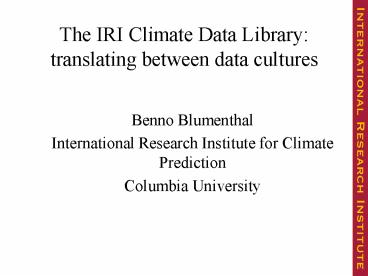The IRI Climate Data Library: translating between data cultures - PowerPoint PPT Presentation
1 / 16
Title:
The IRI Climate Data Library: translating between data cultures
Description:
International Research Institute for Climate Prediction ... equal-area grids. GRIB grid codes. climate divisions. IRI Data. Collection. Dataset. Dataset ... – PowerPoint PPT presentation
Number of Views:36
Avg rating:3.0/5.0
Title: The IRI Climate Data Library: translating between data cultures
1
The IRI Climate Data Library translating between
data cultures
- Benno Blumenthal
- International Research Institute for Climate
Prediction - Columbia University
2
Work presented has been done by
- John del Corral
- Michael Bell
- Emily Grover-Kopec
3
Outline
- Data Cultures
- Needed Functionality for usefully merging
- Data model changes
- Functionality changes
- Example
- Mapping SimpleFeatures to OpenDAP
- Lessons Learned
4
Ocean/Atm geolocated by lat/lon multidimensiona
l
GIS geolocation by vector object or projection
metadata
spectral harmonics equal-area grids GRIB grid
codes climate divisions
- IRI Data
- Collection
- Dataset
- Dataset
- Dataset
- Variable
- ivar
- ivar
- multidimensional
5
GRIB netCDF images binary
spreadsheets
shapefiles
Database Tables queries
Servers OpenDAP THREDDS
images w/proj
- IRI Data
- Collection
- Dataset
- Dataset
- Dataset
- Variable
- ivar
- ivar
6
GRIB netCDF images binary
spreadsheets
shapefiles
Database Tables queries
Servers OpenDAP THREDDS
images w/proj
- IRI Data
- Collection
- Dataset
- Dataset
- Dataset
- Variable
- ivar
- ivar
User Interface viewer manipulations calculations
Calculations virtual variables
Clients OpenDAP THREDDS
Data Files netcdf binary images
Tables
OpenGIS WMS v1.3
7
Functionality for new Users
- want to use our current data holdings
- aggregation (particularly of images)
- time analysis of GIS data
- translation to entity basis
8
Data Model Changes
- projection attributes
- SpatialReferenceSystemWKT (An OpenGIS standard)
- SpatialReferenceSystemDims
- geometry data object
- OpenGIS Simple Feature
9
Functionality Changes
- geometry display fill, fillby, stroke, mark, ...
- projection functionality objects with differing
projection attributes can be made to match - rasterization geometry object converted to
raster - computes the fraction of each gridbox that is
covered by the given geometry object
10
Example
- NDVIx y time
- Albers projection
- and
- location d_name
- Lon/lat geometry
- produces
- NDVIgd_name time
11
weighted-average
12
Simple Features and OpenDAP v2.0 structure
Point structure float latfloat lon point
LineString sequence float latfloat lonLineString
MultiPoint sequence float latfloat lon MultiPoint
Polygon sequence sequence float latfloat lon aring Polygon
MultiLineString sequence sequence float latfloat lon LineStringMultiLineString
MultiPolygon sequence sequence sequence float latfloat lon ring Polygon MultiPolygon
Geometry Collection sequence string OpenGISSimpleFeature sequence...geom GeometryCollectionbut how to handle a collection of a collecton???
13
Simple Features and OpenDAP v2.0 attributes
- SpatialReferenceSystemWKT
- Projection information
- OpenGISSimpleFeature
- Point, LineString, Polygon, MultiPoint,
MultiLineString,MultiPolygon,GeometryCollection - Or
- Dimensionality
- 0 (point) 1 (line) 2 (polygon)
14
Sample Attributes
- NDVI x y time
- SpatialReferenceSystemWKT PROJCS"Albers_Equal_Are
a_Conic",GEOGCS"GCS_North_American_1927",DATUM"D
_North_American_1927",SPHEROID"Clarke_1866",63782
06.4,294.9786982,PRIMEM"Greenwich",0,UNIT"Deg
ree",0.017453292519943295,PROJECTION"Albers",P
ARAMETER"False_Easting",0,PARAMETER"False_North
ing",0,PARAMETER"Central_Meridian",20,PARAMETER
"Standard_Parallel_1",21,PARAMETER"Standard_Par
allel_2",-19,PARAMETER"Latitude_Of_Origin",1,UN
IT"Meter",1 - SpatialReferenceSystemDims
- x y
15
Lessons Learned
- nice to have a location object
- Place to put attributes
- For example, if I have an image ndvix y time
with an Albers projection, clearly the projection
is an attribute of x y. Seeing as x y are
contained in ndvi, putting the SpatialReferenceSys
temWKT attribute almost makes sense, but then I
have to add the other attribute
SpatialReferenceSystemDims to clarify. - But now I have attributes in a container which
sometimes apply up, and sometimes down.
16
Lessons Learned
- Our structural representations (OpenDAP, netCDF)
are missing recursion - Bringing together different concepts in different
data cultures (multidimensionality, location as
object) improves both sides of the divide.






























